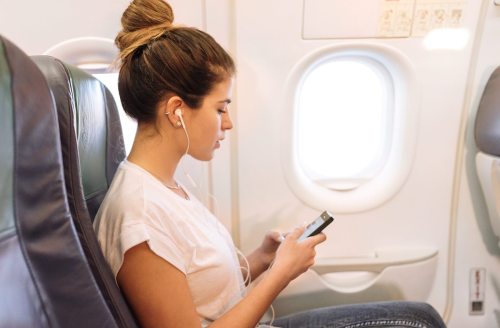Staying sane while jet-setting requires balancing out the things you just can’t control (like long security lines, chatty seatmates, and rubbery food) with the things you can (healthified orders at restaurant chains, essential oils, your travel-size beauty VIPs). The most recent #travelhack to file under the latter category? Keeping the overheard air vent turned on full-blast during all flights.
Since airplanes tend to share roughly the same temp as a meat locker, the idea of keeping a steady stream of not-fresh chilled air blowing toward you for hours on end might sound totally unhealthy. In reality though, the circulation from the tiny overhead vents is pretty much your best bet for not contracting your neighbor’s cold while onboard, reports Travel+Leisure.
“Ventilation on airplanes has gotten a bad reputation, but it’s completely unfounded,” says Mark Gendreau, MD, who specializes in the spread of infectious diseases in airline travel. He explains that the air on a plane doesn’t actually circulate from front to back like you might think. Instead, each plane contains many “temperature control zones” where air enters in through the nozzles above your head, then exits the aircraft either through “grills’ underneath the windows, or where the walls meet the floor at your feet. Before re-entering the plane, the stale air combines with the fresher particles outside and re-enters through a system called a High Efficiency Particulate Air (HEPA for short). That system filters out a whopping 99 percent of dust and microbes in the air. However, it does fall short with regards to one major source of airborne illness.
Pulling on your sweatshirt and dialing up the AC to a low or medium level will create your own personal funnel that blocks particles hanging in the air from invading your bod.
Here’s where individual vents come in handy: According to Dr. Gendreau, airborne viruses like tuberculosis and measles are spread by droplet nuclei that can hang out in your tiny dedicated zone of plane square footage for up to five hours despite the HEPA’s diligent work. Pulling on your sweatshirt and dialing up the AC to a low or medium level will create your own personal funnel that blocks particles hanging in the air from invading your personal space.
Of course, while airing out your sky-high personal bubble will safeguard your immune system, you’ll need to take an extra step to protect your skin against the dehydrating effects of the bacteria-banishing tactic. “To combat skin dryness, make sure to prep your skin before getting on the plane to hydrate and protect the skin barrier during the ride,” advises dermatologist Joshua Zeichner, MD. He recommends slathering on a quenching layer of hyaluronic acid. (Or, to give your skin an extra sip of H2O, try slapping on Emma Roberts’s favorite face mask.) For the rest of your skin, a light lotion that won’t leave you feeling sticky should do the trick.
Of course, flight attendants also know a thing or two about staying healthy a mile high in the sky. For instance, the tap water (and coffee) is filthy, and if you can hold it instead of using the restroom, you probably should.
Sign Up for Our Daily Newsletter
Get all the latest in wellness, trends, food, fitness, beauty, and more delivered right to your inbox.
Got it, you've been added to our email list.









